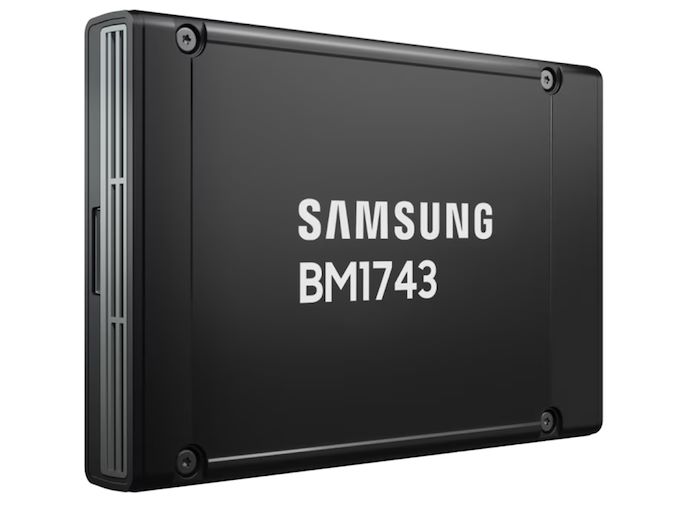Samsung Joins The 60 TB SSD Club, Looking Forward To 120 TB Drives
by Anton Shilov on July 5, 2024 11:00 AM EST
Multiple companies offer high-capacity SSDs, but until recently, only one company offered high-performance 60 TB-class drives with a PCIe interface: Solidigm. As our colleagues from Blocks & Files discovered, Samsung quietly rolled out its BM1743 61.44 TB solid-state drive in mid-June and now envisions 120 TB-class SSDs based on the same platform.
Samsung's BM1743 61.44 TB features a proprietary controller and relies on Samsung's 7th Generation V-NAND (3D NAND) QLC memory. Moreover, Samsung believes that its 7th Gen V-NAND 'has the potential to accommodate up to 122.88 TB,'
Samsung plans to offer the BM1743 in two form factors: U.2 for PCIe 4.0 x4 to address traditional servers and E3.S for PCIe 5.0 x4 interfaces to address machines designed to offer maximum storage density. BM1743 can address various applications, including AI training and inference, content delivery networks, and read-intensive workloads. To that end, its write endurance is 0.26 drive writes per day (DWPD) over five years.
Regarding performance, Samsung's BM1743 is hardly a champion compared to high-end drives for gaming machines and workstations. The drive can sustainably achieve sequential read speeds of 7,200 MB/s and write speeds of 2,000 MB/s. It can handle up to 1.6 million 4K random reads and 110,000 4K random writes for random operations.
Power consumption details for the BM1743 have not been disclosed, though it is expected to be high. Meanwhile, the drive's key selling point is its massive storage density, which likely outweighs concerns over its absolute power efficiency for intended applications, as a 60 TB SSD still consumes less than multiple storage devices offering similar capacity and performance.
As noted above, Samsung's BM1743 61.44 TB faces limited competition in the market, so its price will be quite high. For example, Solidigm's D5-P5336 61.44 TB SSD costs $6,905. Other companies, such as Kioxia, Micron, and SK Hynix, have not yet introduced their 60TB-class SSDs, which gives Samsung and Solidigm an edge for now.
UPDATE 7/25: We removed mention of Western Digital's 60 TB-class SSDs, as the company does not currently list any such drives on their website
Source: Samsung










19 Comments
View All Comments
GeoffreyA - Saturday, July 6, 2024 - link
Wonder when the rest of us get to join the 60 TB Club ;)nandnandnand - Saturday, July 6, 2024 - link
When you start making that dough.Ok seriously, consumer 16 TB M.2 is pretty close. Maybe 2025. Density needs to quadruple to get you to 64 GB. If density grows by 30% a year, we'll get that in about 5.3 years, so around 2030-2031.
https://www.tomshardware.com/pc-components/ssds/16...
nandnandnand - Saturday, July 6, 2024 - link
*64 TBUnfortunately the NAND used will be PLC/HLC
GeoffreyA - Saturday, July 6, 2024 - link
I do wonder about the cost though, and now, going from QLC to PLC. Alas, what's on the horizon after that? DLC...nandnandnand - Saturday, July 6, 2024 - link
6 bpc, 7 bpc, are being seriously considered:https://www.anandtech.com/show/17116/startup-showc...
https://www.kioxia.com/en-jp/rd/technology/topics/...
8 bpc (OLC) NAND has only really been mentioned in a false Wccftech story:
https://wccftech.com/exclusive-micron-octa-level-c...
GeoffreyA - Sunday, July 7, 2024 - link
Yes, it's inevitable. Even beyond those, 6 and 7 bpc, doubtless OLC, ELC, and DLC are going to come at some point. It will interesting to see when a hard limit is reached on this technology. As the CPU, a breakthrough beyond silicon and electrons will be needed at length.kn00tcn - Saturday, July 6, 2024 - link
why are we limiting to m2 slot instead of pcie slot? and that gave me a wild idea: an m2 extension cable that hooks into a new square form factor ssd that mounts onto existing case fan slotsnandnandnand - Saturday, July 6, 2024 - link
You aren't really limited by anything but money. You can go buy this 60 TB SSD right now and use an adapter to fit it in a typical consumer system. But only a certain amount of chips can fit on M.2 2280/2580/25110, so that would keep the cost in check.[email protected] - Saturday, July 6, 2024 - link
My understanding is this is a PCIE device. Not an M.2 device. So the cable would go to an M.2 connection on the mobo to a PCIE connection on the device.Silver5urfer - Sunday, July 7, 2024 - link
Consumers ate up M.2 and don't want a high performing U.2 standard which is used in Enterprise and many people want simple garbage storage and latency laden non consistent M.2 SSDs. not a single M.2 drive will retain it's BS marketing PR numbers after 900 Seconds. Only Solid State Storage that does is OPTANE which is dead or that old SLC which also dead.